Punjab State Board PSEB 11th Class Chemistry Book Solutions Chapter 7 Equilibrium Textbook Exercise Questions and Answers.
PSEB Solutions for Class 11 Chemistry Chapter 7 Equilibrium
PSEB 11th Class Chemistry Guide Equilibrium InText Questions and Answers
Question 1.
A liquid is in equilibrium with its vapour in a sealed container at a fixed temperature. The volume of the container is suddenly increased.
(a) What is the initial effect of the change on vapour pressure?
(b) How do rates of evaporation and condensation change initially?
(c) What happens when equilibrium is restored finally and what will be the final vapour pressure?
Answer:
(a) If the volume of the container is suddenly increa50sed, then the vapour pressure would decrease initially. This is because the amount of vapour remains the same, but the volume increases suddenly. As a result, the same amount of vapour is distributed in a larger volume.
(b) Since the temperature is constant, the rate of evaporation also remains constant. When the volume of the container is increased, the density of the vapour phase decreases. As a result, the rate of collisions of the vapour particles also decreases. Hence, the rate of condensation decreases initially.
(c) When equilibrium is restored finally, the rate of evaporation becomes equal to the rate of condensation. In this case, only the volume changes while the temperature remains constant. The vapour pressure depends on temperature and not on volume. Hence, the final vapour pressure will be equal to the original vapour pressure of the system.
Question 2.
What is Kc for the following equilibrium when the equilibrium concentration of each substance is: [SO2] = 0.60M,[O2] = 0.82M and [SO3] = 1.90 M?
2SO2(g) + O2(g) ↔ 2SO3(g)
Answer:
The given reaction is
2SO2(g) + O2(g) ↔ 2SO3(g)
Equilibrium constant
Kc = \(\frac{\left[\mathrm{SO}_{3}\right]^{2}}{\left[\mathrm{SO}_{2}\right]^{2}\left[\mathrm{O}_{2}\right]}=\frac{(1.90 \mathrm{M})^{2}}{(0.60 \mathrm{M})^{2}(0.82 \mathrm{M})}\)
= 12.238 M-1
![]()
Question 3.
At a certain temperature and total pressure of 105 Pa, iodine vapour contains 40% by volume of I atoms I2(g) ⇌ 2I(g)
Calculate Kp for the equilibrium.
Answer:
Given, I2(g) ⇌ 2I(g)
I atoms in iodine vapours = 40% by volume
So, iodine vapours of I2 molecules = 60% by volume
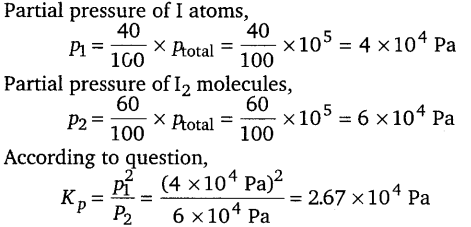
Question 4.
Write the expression for the equilibrium constant, Kc for each of the following reactions:
(i) 2NOCl(g) ⇌ 2NO (g) + Cl2(g)
(ii) 2CU(NO3)2(S) ⇌ 2CuO(s) + 4NO2(g) + O2(g)
(iii) CH3COOC2H5(oq) + H2O(l) ⇌ CH3COOH(aq) + C2H5OH(ag)
(iv) Fe3+(aq) + 3OH–(aq) ⇌ Fe(OH)3(s)
(v) I2(s) + 5F2 ⇌ 2IF5
Answer:
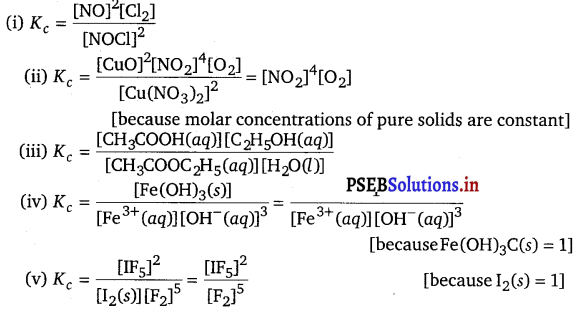
Question 5.
Find out the value of Kc for each of the following equilibria from the value of Kp.
(i) 2NOCl(g) ⇌ 2NO(g) + Cl2(g); Kp = 1.8 x 10-2 at 500 K
(ii) CaCO3(s) ⇌ CaO(s) + CO2(g); Kp = 167 at 1073 K
Answer:
The relation between Kp and Kc is given as
Kp = Kc(RT)Δn
(i) 2NOCl(g) ⇌ 2NO(g) + Cl2(g); Kp = 1.8 x 10-2 at 500 K.
Δn = 3 – 2 = 1
R = 0.0831 bar L mol-1K-1
T = 500 K
Kp =1.8 x 10-2
Kp = Kc( RT)Δn
1.8 x 10-2 = Kc(0.0831 x 500)1
Kc = \(\frac{1.8 \times 10^{-2}}{0.0831 \times 500}\) = 4.33 x 10-4
(ii) CaCO3(s) ⇌ CaO(s) + CO2(g); Kp = 167 at 1073 K
Δn = 2 -1 = 1
R = 0.0831 bar L mol-1K-1
T = 1073 K
Kp =167
Now, Kp = Kc(RT)Δn
⇒ 167 = Kc(0.0831 x 1073)1
⇒ Kc = \(\frac{167}{0.0831 \times 1073}\) = 1.87
Question 6.
For the following equilibriuih, Kc = 6.3 x 1014 at 1000 K
NO(g) + O3(g) ⇌ NO2(g) + O2(g)
Both the forward and reverse reactions in the equilibrium are elementary bimolecular reactions. What is Kc, for the reverse reaction?
Answer:
It is given that Kc for the forward reaction is 6.3 x 1014 at 1000 K.
Then, Kc for the reverse reaction will be,
NO2(g) + O3(g) ⇌ NO(g) + O3(g)
Kc = \(\frac{1}{K_{c}}=\frac{1}{6.3 \times 10^{14}}\) = 1.59 x 10-15
Question 7.
Explain why pure liquids and solids can be ignored while writing the equilibrium constant expression?
Answer:
For a pure substance (both solids and liquids),

Now, the molecular mass and density (at a particular temperature) of a pure substance is always fixed and is accounted for in the equilibrium constant. Therefore, the values of pure substances are not mentioned in the equilibrium constant expression.
![]()
Question 8.
Reaction between N2 and O2 takes place as follows:
2N2(g) + O2(g) ⇌ 2N2O(g)
If a mixture of 0.482 mol of N2 and 0.933 mol of O2 is placed in a 10 L reaction vessel and allowed to form N2O at a temperature for which Kc = 2.0 x 10-37 , determine the composition of equilibrium mixture.
Answer:
Let the concentration of N2O at equilibrium be x.
The given reaction is :
![]()
The value of equilibrium constant i.e., Kc = 2.0 x 10-37 is very small which means negligible amounts of N2 and O2 react.
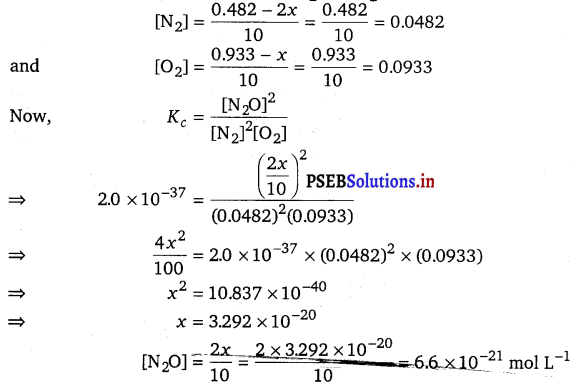
Question 9.
Nitric oxide reacts with Br2 and gives nitrosyl bromide as per reaction given below:
2NO(g) + Br2(g) ⇌ 2NOBr(g)
When 0.087 mol of NO and 0.0437 mol of Br2 are mixed in a closed container at constant temperature, 0.0518 mol of NOBr is obtained at equilibrium. Calculate equilibrium amount of NO andBr2.
Answer:
The balanced chemical equation is

Given, 2x = 0.0518
x = 0.0259 mol
Moles of NO at equilibrium = 0.087 – 2x
= 0.087-0.0518
= 0.0352 mol
Moles of Br2 at equilibrium = 0.0437 – x
= 0.0437 – 0.0259
= 0.0178 mol
Question 10.
At 450 K, Kp = 2.0 x 1010/bar for the given reaction at equilibrium.
2SO2(g) + O2(g) ⇌ 2SO3(g)
What is Kc at this temperature?
Answer:
The given reaction is
2SO2(g) + O2(g) ⇌ 2SO3Cg)
Δn = 2 – 3 = -1
T = 450 K
R = 0.0831 bar L K-1 mol-1
Kp = 2.0 x 1010 bar-1
We know that,
Kp = Kc(RT)Δn
=> 2.0 x 1010 bar-1 = kc(0.0831 L bar K-1 mol-1 x 450 K)-1
\(K_{c}=\frac{2.0 \times 10^{10} \mathrm{bar}^{-1}}{\left(0.0831 \mathrm{~L} \mathrm{barK} \mathrm{K}^{-1} \mathrm{~mol}^{-1} \times 450 \mathrm{~K}\right)^{-1}}\)
Kc = (2.0 x 1010 bar-1) (0.0831 L bar K-1mol-1450 K)
= 74.79 x 1010 L mol-1 = 7.48 x 1011 L mol-1
Question 11.
A sample of HI(g) is placed in flask at a pressure of 0.2 atm. At equilibrium the partial pressure of HI(g) is 0.04 atm. What is Kp for the given equilibrium?
2HI(g) ⇌ H2(g) + I2(g)
Answer:
The given reaction is

∵ Decrease is pressure of HI = 0.2 – 0.04 = 0.16 atm;
So equilibrium pressure of H2 is \(\frac{0.16}{2}\) = 0.08 atm and for I2 is \(\frac{0.16}{2}\) = 0.08 atm
as two moles of HI on dissociation gives 1 mol of H2 and 1 mol of I2.
Therefore,
Kp = \(\frac{p_{\mathrm{H}_{2}} \times p_{\mathrm{I}_{2}}}{\left(p_{\mathrm{HI}}\right)^{2}}=\frac{0.08 \times 0.08}{(0.04)^{2}}=\frac{0.0064}{0.0016}\) = 4.0
Hence, the value of Kp is 4.0.
Question 12.
A mixture of 1.57 mol of N2,1.92 mol of H2 and 8.13 mol of NH3 is introduced into a 20 L reaction vessel at 500 K. At this temperature, the equilibrium constant, Kc for the reaction
N2(g) + 3H2(g) ⇌ 2NH3(g) is 1. 7 x 102.
Is the reaction mixture at equilibrium? If not, what is the direction of the net reaction?
Answer:
The given reaction is :
N2(g) + 3H2(g) 2NH3(g)
Given, [N2] = \(\frac{1.57}{20}\) = 0.0785 M
[H2] = \(\frac{1.92}{20}\) = 0.096 M
[NH3] = \(\frac{8.13}{20}\) = 0.4065 M
Now, reaction quotient Qc. is :
Qc = \(\frac{\left[\mathrm{NH}_{3}\right]^{2}}{\left[\mathrm{~N}_{2}\right]\left[\mathrm{H}_{2}\right]^{3}}=\frac{(0.4065)^{2}}{(0.0785)(0.096)^{3}}\) = 2.4 x 103M-2
Since Qc ≠ Kc the reaction mixture is not in equilibrium.
Again Qc > Kc. Hence, the reaction will proceed in the reverse direction.
![]()
Question 13.
The equilibrium constant expression for a gas reaction is, Kc = \(\frac{\left[\mathrm{NH}_{3}\right]^{4}\left[\mathrm{O}_{2}\right]^{5}}{\left[\mathrm{NO}^{4}\left[\mathrm{H}_{2} \mathrm{O}\right]^{6}\right.}\)
Write the balanced chemical equation corresponding to this expression.
Answer:
The balanced chemical equation corresponding to the given expression can be written as :
4NO(g) + 6H2O(l) ⇌ 4NH3(g) + 5O2(g)
Question 14.
One mole of H2O and one mole of CO are taken in 10 L vessel and heated to 725 K. At equilibrium 40% of water (by mass) reacts with CO according to the equation,
H2O(g) + CO(g) ⇌ H2(g) + CO2(g)
Calculate the equilibrium constant for the reaction.
Answer:
The given reaction is

H2O reacted = 40% of 1 mol of H2O = 0.4 mol
x = 0.4 mol 1 – x = 1 – 0.4 = 0.6 mol
Therefore, the equilibrium constant for the reaction,
Kc = \(\) = 0.444
Question 15.
At 700 K, equilibrium constant for the reaction
H2(g) + I2(g) ⇌ 2HI(g)
is 54.8. If 0.5 mol L-1 of Hl(g) is present at equilibrium at 700 K, what are the concentration of H2(g) and I2(g) assuming that we initially started with HI(g) and allowed it to reach equilibrium at 700 K?
Answer:
The given reaction is
H2(g) + I2(g) ⇌ 2HI(g); Kc = 54.8
Or the reaction
2HI(g) ⇌ H2(g) + I2(g); Kc‘ = \(\)
Given, [HI] = 0.5 mol L-1
According to equation
[H2] = [I2] = x mol L-1
Therefore,
\(\frac{\left[\mathrm{H}_{2}\right]\left[\mathrm{I}_{2}\right]}{[\mathrm{HI}]^{2}}=K_{c}^{\prime}\)
⇒ \(\frac{x \times x}{(0.5)^{2}}=\frac{1}{54.8}\)
⇒ x2 = \(\frac{0.25}{54.8}\)
⇒ x = 0.06754
x = 0.068 mol L-1
Hence, at equilibrium, [H2] = [I2] = x = 0.068 mol L-1
Question 16.
What is the equilibrium concentration of each of the substances in the equilibrium when the initial concentration of IC1 was 0.78 M?
2ICl(g) ⇌ I2(g) + Cl2(g); Kc = 0.14
Answer:

Question 17.
Kp = 0.04 atm at9 K for the equilibrium shown below. What is the equilibrium concentration of C2H6 when it is placed in a flask at 4.0 atm pressure and allowed to come to equilibrium?
Answer:
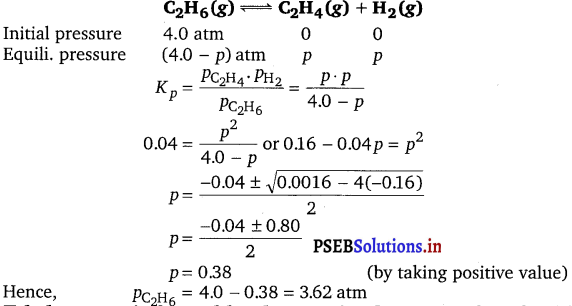
Question 18.
Ethyl acetate is formed by the reaction between ethanol acid and acetic acid and the equilibrium is represented as :
CH3COOH(l) + C2H5OH (l) ⇌ CH3COOC2H5(Z) + H2O(l)
(i) Write the concentration ratio (reaction quotient), Qc, for this reaction (note: water is not in excess and is not a solvent in this reaction)
(ii) At 293 K, if one starts with 1.00 mol of acetic acid and 0.18 mol of ethanol, there is 0.171 mol of ethyl acetate in the final equilibrium mixture. Calculate the equilibrium constant.
(iii) Starting with 0.5 mol of ethanol and 1.0 mol of acetic acid and maintaining it at 293 K, 0.214 mol of ethyl acetate is found after sometime. Has equilibrium been reached?
Answer:
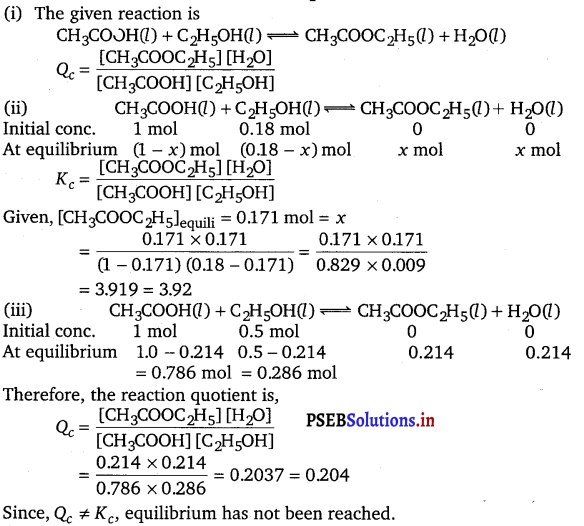
Question 19.
A sample of pure PCl5 was introduced into an evacuated vessel at 473K. After equilibrium was attained, concentration of PCl5 was found to be 0.5 x 10-1 mol L-1. If value of K is 8.3 x 10-3, what are the concentrations of PCl3 and Cl2 at equilibrium?
PCl5 (g) ⇌ PCl3(g) + Cl2(g)
Answer:
The given reaction is

It is given that the value of equilibrium constant, K = 8.3 x 10-3.
Kc = \(\frac{\left[\mathrm{PCl}_{3}\right]\left[\mathrm{Cl}_{2}\right]}{\left[\mathrm{PCl}_{5}\right]}\)
[Given, [PCl5]equili = 0.5 x 10-1 mol L-1]
\(\frac{x \times x}{0.5 \times 10^{-1}}\) = 8.3 x 10-3
⇒ x2 = 4.15 x10-4
⇒ x = 2.04 x 10-2 = 0.0204 mol L-1 = 0.02 mol L-1
Therefore, at equilibrium,
[Pcl3] = [Cl2] = 0.02 mol L-1
![]()
Question 20.
One of the reaction that takes place in producing steel from iron ore is the reduction of iron (H) oxide by carbon monoxide to give iron metal and CO2.
FeO(s) + CO(g) ⇌ Fe(s) + CO2 (g); Kp = 0.265 atm at 1050 K. What are the equilibrium partial pressures of CO and 2 at 1050 K if the initial partial pressures are PCo = 1.4 atm and pCO2 = 0.80 atm?
Answer:
(i) The given reaction is

Since Qp > Kp, the reaction will proceed in the backward direction.
Therefore, we can say that the pressure of CO will increase while the pressure of CO2 will decrease.
Now,let the increase in pressure of CO = decrease in pressure of CO2 be p.
Hence pCO2 = 0.80 – p and PCO = 1.4 + p
and Kp = \(\frac{p_{\mathrm{CO}_{2}}}{p_{\mathrm{CO}}}\)
0.265 = \(\frac{0.80-p}{1.4+p}\)
0.371 + 0.265p = 0.80 — p= 1.265p= 0.429
p = 0.339atm
Hence, at equilibrium
PCO2 = 0.80 – 0.339 = 0.461 atm
And, equilibrium partial pressure of
PCO = 1.4 + 0.339 = 1.739 atm.
Question 21.
Equilibrium constant, Kc for the reaction
N2(g) + 3H2(g) ⇌ 2NH3(g) at 500 K is 0.06 1.
At a particular time, the analysis shows that composition of the
reaction mixture is 3.0 mol L-1 N2,2.0 mol L-1 H2 and 0.5 mol L-1 NH3 Is the reaction at equilibrium? if not in which direction
does the reaction tend to proceed to reach equilibrium?
Answer:
The given reaction is
N2(g) + 3H2(g) ⇌ 2NH3(g);Kc = 0.061 at 500K
Given, [N2] = 3.0mol L-1, [H2] = 2.0 mol L-1, [NH3] = 0.5 mol L-1
So, Q = \(\frac{\left[\mathrm{NH}_{3}\right]^{2}}{\left[\mathrm{~N}_{2}\right]\left[\mathrm{H}_{2}\right]^{3}}=\frac{(0.5)^{2}}{(3.0)(2.0)^{3}}\) = 0.0104
It is given that Kc = 0.06 1
Since Qc ≠ Kc, the reaction is not at equilibrium.
Since Qc < Kc, the reaction will proceed in the forward direction to reach equilibrium.
Question 22.
Bromine monochloride, BrCl decomposes into bromine and chlorine and reaches the equilibrium:
2BrCl(g) ⇌ Br2(g) + Cl2(g)
for which Kc = 32 at 500 K. If initially pure BrCl is present at a concentration of 3.3 x 10-3 mol L-1, what is its molar concentration in the mixture at equilibrium?
Answer:
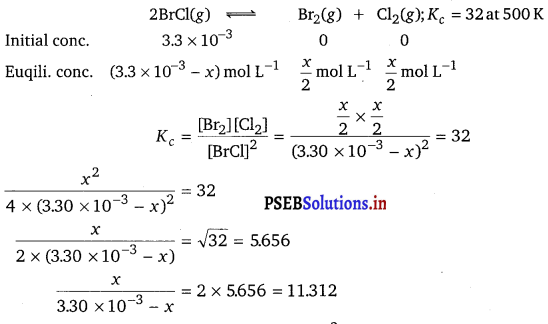
x = 11.312(3.30 x 10-3 – x)
x = 0.03732 – 11.312x
x + 11.312x = 0.03732
x = \(\frac{0.03732}{12.312}\)= 3.0321 x 10-3 mol L-1
[BrCl]equili = (3.30 x 10-3 – 3.032 x 10-3) mol L-1
= 2.68 x 10-4 mol L-1
Question 23.
At 1127 K and 1 atm pressure, a gaseous mixture of CO and CO2 in equilibrium with solid carbon has 90.55% CO by mass
C(s) + CO2(g) ⇌ 2CO(g)
Calculate Kc for this reaction at the above temperature.
Answer:
Let the total mass of the gaseous mixture be 100g.
Mass of CO = 90.55 g
and, mass of CO2 = (100 – 90.55) = 9.45 g
Now, number of moles of CO,
nCO = \(\frac{90.55}{28}\) = 3.234 mol
(Molar mass of CO = 28 g mol-1 )
Now, number of moles of CO2,
nCO = \(\)
(Molar mass of CO2 = 44 g mol-1 )

For the given reaction, Δn = 2 -1 = 1
We know that,
Kp = Kc(RT)Δn
⇒ 14.19 = Kc(0.0831 x 1127)1
⇒ Kc = 0.154 (approximately)
![]()
Question 24.
Calculate (a) \(\Delta \boldsymbol{G}^{\ominus}\) and (b) the equilibrium constant for the formation of N02 from NO and Oa at 298K
NO(g) + \(\frac{1}{2}\)O2(g) ⇌ NO2(g)
where \(\Delta_{f} \boldsymbol{G}^{\ominus}\) (N02)= 52.0 kJ/mol; \(\Delta_{f} \boldsymbol{G}^{\ominus}\) (NO) = 87.0kJ/mol;
\(\Delta_{f} \boldsymbol{G}^{\ominus}\) (O2) = 0 kJ/mol
Answer:
(a) The given reaction is
N0(g) + \(\frac{1}{2}\)O2(g) ⇌ NO2(g)

= (52.0 – 87.0 + \(\frac{1}{2}\) x 0 )kJ mol-1 = -35.0 kJ mol-1
(b) \(\Delta_{r} G^{\ominus}\) = – 2.303 RT logKc
-35.0 = – 2.303 x 0.0831 x 298 log Kc
∴ log Kc= \(\frac{35}{5.7058}\)= 6.134
∴ Kc = antilog 6.134 = 1.361 x 106.
Question 25.
Does the number of moles of reaction products increase, decrease or remain same when each of the following equilibria is subjected to a decrease in pressure by increasing the volume?
(a) PCl5(g) ⇌ PCl3(g) +Cl2(g)
(b) CaO (s) + CO2 (g) ⇌ CaCO3 (s)
(c) 3Fe(s) + 4H2O (g) ⇌ Fe3O4 (s) + 4H5(g)
Answer:
(a)The number of moles of reaction products will increase. According to Le-Chatelier’s principle, if pressure is decreased, then the equilibrium shifts in the direction in which the number of moles of gases is more. In the given reaction, the number of moles of gaseous products is more than that of gaseous reactants. Thus, the reaction will proceed in the forward direction. As a result, the number of moles of reaction products will increase.
(b) The number of moles of reaction products will decrease.
(c) The number of moles of reaction products remains the same
Question 26.
Which of the following reactions will get affected hy increasing the pressure?
Also, mention whether change will cause the reaction to go into forward or backward direction.
(i) COCl2(g) ⇌ CO(g) +Cl2(g)
(ii) CH4(g) + 2S2(g) ⇌ CS2(g) + 2H2S(g)
(iii) CO2(g) + C(S) ⇌ 2CO(g)
(iv) 2H2(g) +CO(g) ⇌ CH3OH(g)
(v) CaCO3(s) ⇌ CaO(s) + CO2(g)
(vi) 4NH3(g) + 5O2(g) ⇌ 4NO(g) + 6H2O(g)
Answer:
In all the above reactions, the reaction no. (ii) proceeds with the same no. of moles on both sides
i.e., np = nr = 3 .
∴ This reaction will not be affected by the increase in pressure i. e., the direction of equilibrium will not be affected by the increase in pressure. All other reactions will be affected by the increase in pressure.
(i) COCl2(g) ⇌ CO(g) +Cl2(g)
np > nr , np = 2; nr = 1
∴ Equilibrium will shift to the left increasing pressure.
(iii) CO2(g) + C(S) ⇌ 2CO(g)
Here, nr – 1; np = 2, therefore np > nr
∴ Equilibrium will go to left on increase of pressure.
(iv) 2H2(g) +CO(g) ⇌ CH3OH(g)
Here, nr = 3; np = 1 therefore np < nr
∴ Equilibrium will shift to the right on increasing pressure.
(v) CaCO3(s) ⇌ CaO(s) + CO2(g)
Here nr = 0; np = 1, therefore np > nr
∴ Equilibrium will shift backwards (left) on increasing the pressure.
(vi) 4NH3(g) + 5O2(g) ⇌ 4NO(g) + 6H2O(g)
Here nr = 9; np = 10, therefore np > nr
∴ Equilibrium will shift backwards on increasing the pressure.
Question 27.
The equilibrium constant for the following reaction is 1.6 x 105 at 1024 K.
H2(g) + Br2(g) ⇌ 2HBr(g)
Find the equilibrium pressure of all gases if 10.0 bar of HBr is introduced into a sealed container at 1024K.
Answer:
Given reaction is H2(g) + Br2(g)⇌ 2HBr(g); Kp = 1.6 x 105 at 1024 K
Therefore, for the reaction 2HBr(g) ⇌ H2(g)+Br2(g), the equilibrium constant will be,
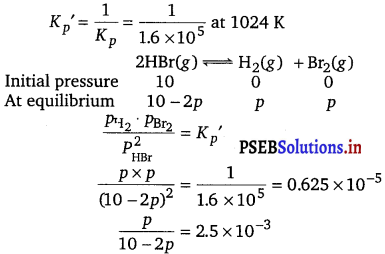
p = 2.5 x 1-2(5.0 x 10-3)p
p+(5.0 x 10-3)p = 2.5 x 10-2
(1005 x 10-3)p = 2.5 x 10-2
p = 2.49 x 10-2 bar = 2.5 x 10-2 bar
rherefore, at equilibrium,
[H2] = [Br2] = 2.49 x 10-2 bar
[HBr] =10 — 2 x (2.49 x 10-2) bar
= 9.95 bar = 10 bar
Question 28.
Dihydrogen gas is obtained from natural gas by partial oxidation with steam as per following endothermic reaction:
CH4(g) + H2O(g) ⇌ CO(g) + 3H2(g)
(a) Write an expression for Kp for the above reaction.
(b) How will the values of kp and composition of equilibrium mixture be affected by
(i) increasing the pressure
(ii) increasing the temperature
(iii) Using a catalyst?
Answer:
(a) The given reaction is
CH4(g) + H4O(g) ⇌ CO(g) + 3H2(g)
\(K_{p}=\frac{p_{\mathrm{CO}} \times p_{\mathrm{H}_{2}}^{3}}{p_{\mathrm{CH}_{4}} \times p_{\mathrm{H}_{2} \mathrm{O}}}\)
(b) (1) According to LeChatelier’s principle, the equilibrium will shift in the backward direction.
(ii) According to Le-Chatelier’s principle, as the reaction is endothermic, the equilibrium will shift in the forward direction.
(iii) The equilibrium of the reaction is not affected by the presence of a catalyst. A catalyst only increases the rate of a reaction. Thus, equilibrium will be attained quickly.
![]()
Question 29.
Describe the effect of:
(a) addition of H2
(b) addition of CH3OH
(e) removal of CO (d) removal of CH3OH
on the equilibrium of the reaction:
2H2(g) + CO (g) ⇌ CH3OH(g)
Answer:
2H2(g) + CO(g) ⇌ CH3OH(g)
According to Le Chatelier’s principle,
(a) Addition of H2 (increase in concentration of reactants) shifts the equilibrium in forward direction (more product is formed).
(b) Addition of CH3OH (increase in concentration of product) shifts the equilibrium in backward direction.
(c) Removal of CO also shifts the equilibrium in backward direction.
(d) Removal of CH3OH shifts the equilibrium in forward direction.
Question 30.
At 473K, equilibrium constant Kc for decomposition of phosphorus pentachloride, PCl5 is 8.3 x 10-3. If decomposition is depicted as,
PCl5(g) ⇌ PCl3(g) + Cl2(g); \(\Delta_{\boldsymbol{r}} \boldsymbol{H}^{\ominus}\) = 1240 kJ mol-1
(a) Write an expression for Kc for the reaction.
(b) What is the value of Kc for the reverse reaction at the same temperature?
(c) What would be the effect on Kc if
(i) more PCl5 is added
(ii) pressure is increased?
(iii) the temperature is increased?
Answer:
PCl5(g) ⇌ PCl3(g) + Cl2(g); Kc = 8.3 x 10-3
(a) Kc = \(\frac{\left[\mathrm{PCl}_{3}\right]\left[\mathrm{Cl}_{2}\right]}{\left[\mathrm{PCl}_{5}\right]}\)
(b) Value of Kc for the reverse reaction at the same temperature is
K’c = \(\frac{1}{K_{c}}=\frac{1}{8.3 \times 10^{-3}}\) = 1.2048 x 102 = 120.48
(c) (i) Addition pf PCl5 have no effect on Kc because Kc is constant at constant temperature.
(ii) Kc does not change with pressure.
(iii) The given reaction is endothermic, hence on increasing the temperature, Kc will increase.
Question 31.
Dihydrogen gas used in Haber’s process is produced by reacting methane from natural gas with high temperature steam. The first stage of two stage reaction involves the formation of CO and H2. In second stage, CO formed in first stage is reacted with more steam in water gas shift reaction,
CO(g) +H2O (g) ⇌ CO2(g) + H2(g)
If a reaction vessel at 400° C is charged with an equimolar mixture of CO and steam such that pCO = PH2O = 4.0 bar, what will be the partial pressure of H2 at equilibrium? KP = 10.1 at 400°C
Answer:
The given reaction is
CO(g) + H20(g) ⇌ C02(g) + H2(g)
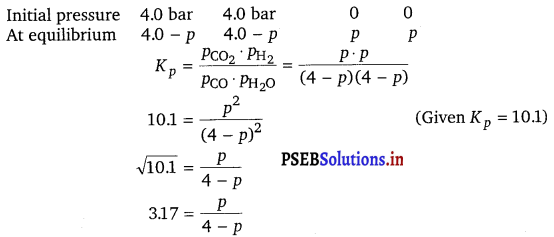
p = 12.71 – 3.17p
4.17 p = 12.71
p = \(\frac{12.71}{4.17}\) = 3.04 bar
Hence PH2 = 3.04 bar
Question 32.
Predict which of the following reaction will have appreciable concentration of reactants and products:
(a) Cl2(g) ⇌ 2Cl(g);Kc = 5 x 10-39
(b) Cl2(g) + 2NO(g) ⇌ 2NOCl(g); Kc = 3.7 x 108
(c) Cl2(g) + 2NO2(g) ⇌ 2NO2Cl(g); Kc = 1.8
Answer:
Following conclusions can be drawn from the values of Kc:
(a) Since the value of Kc is very small, this means that the molar concentration of the products is very small as compared to that of the reactants.
(b) Since the value of Kc is quite large, this means that the molar concentration of the products is very large as compared to that of the reactants.
(c) Since the value of Kc is 1.8, this means that both the products and reactants have appreciable concentration.
Question 33.
The value of Kc for the reaction
3O2(g) ⇌ 2O3(g)
is 2.0 x 10-50 at 25°C. If the equilibrium concentration of O2 in air at 25°C is 1.6 x 10-2, what is the concentration of O3?
Answer:
The given reaction is
3O2(g) ⇌ 2O3(g)
Then K
It is given that Kc = 2.0 x 10-50 and [02(g)] = 1.6 x 10-2
Then, we have,
\(2.0 \times 10^{-50}=\frac{\left[\mathrm{O}_{3}\right]^{2}}{\left[1.6 \times 10^{-2}\right]^{3}}\)
⇒ [O3]2 = 2.0 x 10-50 x (1.6 x 10-2)3
⇒ [O3]2 = 8.192 x 10-56
⇒ [O3] = 2.86 x 10-28 M
Hence, the concentration of O3 is 2.86 x 10-28 M.
Question 34.
The reaction, CO(g) + 3H2(g) ⇌ CH4(g) + H2O(g) is at equilibrium at 1300 K in a 1L flask. It also contain 0.30 mol of CO, 0.10 mol of H2 and 0.02 mol of H20 and an unknown amount of CH4 in the flask. Determine the concentration of CH4 in the mixture. The equilibrium constant, Kc for the reaction at the given temperature is 3.90.
Answer:
The given equation is
CO(g) + 3H2(g) ⇌ CH4(g) + H2O(g)
Therefore,
\(\frac{\left[\mathrm{CH}_{4}\right]\left[\mathrm{H}_{2} \mathrm{O}\right]}{[\mathrm{CO}]\left[\mathrm{H}_{2}\right]^{3}}=K_{c}\)
Given, Kc = 3.90, [CO] = 0.30 mol, [H2] = 0.10 mol and [H2O] \(\frac{\left[\mathrm{CH}_{4}\right] \times 0.02}{0.3 \times(0.1)^{3}}\) = 3.90
[CH4] = \(\frac{3.90 \times 0.3 \times(0.1)^{3}}{0.02}=\frac{0.00117}{0.02}\)
= 0.0585 M= 5.85 x 10-2M
Hence, the concentration of CH4 at equilibrium is 5.85 x 10-2 M.
![]()
Question 35.
What is meant by the conjugate acid-base pair? Find the conjugate acid/base for the following species :
\(\mathrm{HNO}_{2}, \mathrm{CN}^{-}, \mathrm{HClO}_{4}, \mathrm{~F}^{-}, \mathrm{OH}^{-}, \mathrm{CO}_{3}^{2-} \text { and } \mathrm{S}^{2-}\)
Answe:
A conjugate acid-base pair is a pair that differs only by one proton.
The conjugate acid-base for the given species is mentioned in the table below:
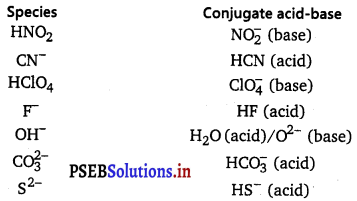
Question 36.
Which of the followings are Lewis acids
\(\mathbf{H}_{2} \mathbf{O}, \mathbf{B F}_{3}, \mathrm{H}^{+} \text {and } \mathrm{NH}_{4}^{+}\)
Answer:
Lewis acids are those acids which can accept a pair of electrons. For example, BF3, H+ and \(\mathrm{NH}_{4}^{+}\) are Lewis acids.
Question 37.
What will be the conjugate bases for the Bronsted acids : HF, H2SO4 and \(\mathrm{HCO}_{3}^{-}\)?
Answer:
The table below lists the conjugate bases for the given Bronsted acids :

Question 38.
Write the conjugate acids for the following Bronsted bases: \(\mathbf{N H}_{2}^{-}\), NH3 andHCOC–.
Answer:
The table below lists the conjugate acids for the given Bronsted bases : Bronsted base Conjugate acid

Question 39.
The species : H2O, HCO–3, HSO–4 and NH3 can act both as Bronsted acids and bases. For each case give the corresponding conjugate acid and base.
Answer:
The table below lists the conjugate acids and conjugate bases for the given species :

Question 40.
Classify the following species into Lewis acids and Lewis bases and show how these act as Lewis acid/base: (a) OH– (b)F– (c)H+ (d) BCl3
OH– and F– are electron rich species and can donate electron pair. Hence, these act as Lewis base.

H+ and BCl3 are electron deficient species and can accept electron pair. Hence, these act as Lewis acid.

Question 41.
The concentration of hydrogen ion in a sample of soft drink is 3.8 x 10-3 M. What is its pH?
Answer:
Given,
[H+] = 3.8 x 10-3 M
∴ pH value of soft drink = – log[H+] = – log(3.8 x 10-3)
= – log3.8 – log10-3 = – log3.8 + 3 log10
= – log3.8 + 3
= -0.58 + 3
= 2.42
Question 42.
The pH of a sample of vinegar is 3.76. Calculate the concentration of hydrogen ion in it.
Answer:
Given, pH = 3.76
We know that,
pH = – log[H+]
⇒ log[H+] = -pH
⇒ [H+] = antilog (-pH)
= antilog (-3.76) -1 +1 = antilog \(\overline{4} .24\) = 1.74 x 10-4 M Hence, the concentration of hydrogen ion in the given sample of vinegar is 1.74 x 10-4 M.
Question 43.
The ionization constant of HF, HCOOH and HCN at 298 K are 6.8 x 10-4, 1.8 x 10-4 and 4 8 x 10-9 respectively. Calculate the ionization constants of the corresponding conjugate base.
Answer:
If Ka is the ionization constant of a weak acid and Kb is the ionization constant of its conjugate base then Ka.Kb = Kw
or Kb = \(\frac{K_{w}}{K_{a}}\)
Given, Ka of HF = 6.8 x 10-4
Hence, Kb of its conjugate base F–
= \(\frac{K_{w}}{K_{a}}=\frac{1 \times 10^{-14}}{6.8 \times 10^{-4}}\)= 1.5 x 10-11
(Kw = ionic product of water =1 x 10-14 at 298 K)
Given, Ka of HCOOH = 1.8 x 10-4
= \(\frac{K_{w}}{K_{a}}=\frac{1 \times 10^{-14}}{1.8 \times 10^{-4}}\) = 5.6 x 10-11
Hence, Kb of its coagulate base CN–
Given, Ka of HCN = 4.8 x 10-9
Hence, Kb of its coagulate base HCOO–
= \(\frac{K_{w}}{K_{a}}=\frac{1 \times 10^{-14}}{4.8 \times 10^{-9}}\) = 2.08 x 10-6
![]()
Question 44.
The ionization constant of phenol is 1.0 x 10-10. What is the concentration of phenolate ion in 0.05 M solution of phenol? What will be its degree of ionization if the solution is also 0.01 M in sodium phenolate?
Answer:
Ionization of phenol :
C6H5OH + H2O ⇌ C6H5O– + H3O+
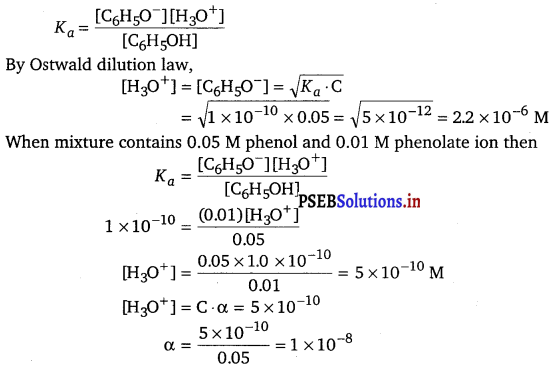
Question 45.
The first ionization constant of H2S is 9.1 x 10-8. (i) Calculate the concentration of HS– ion in its 0.1 M solution. (ii) How will this concentration be affected if the solution is 0.1 M in HCI also? (ifi) If the second dissociation constant of H2S is 1.2 x 10-13, calculate the concentration of S2- under both conditions.
Answer:

Hence, concentration of [HS–] is decreased in the presence of 0.1 M
HCI due to common-ion effect.
(iii) For second dissociation constant,
HS + H2O ⇌ H3O+ + S2- (In absence of HCl)
[HS–] = 9.54 x 10-5 M
\(K_{a_{2}}=\frac{\left[\mathrm{H}_{3} \mathrm{O}^{+}\right]\left[\mathrm{S}^{2-}\right]}{\left[\mathrm{HS}^{-}\right]}\)

Question 46.
The ionization constant of acetic acid is 1.74 x 10-5. Calculate the degree of dissociation of acetic acid in its 0.05 M solution. Calculate the concentration of acetate ion in the solution and its pH.
Answer:
CH3COOH CH3COO– + H+
Ka for CH3COOH = 1.74 x 10-5
[CH3COOH] = c = 0.05 M
CH3COOH CH3COO– + H+ [where α = degree of dissociation and c = molar concentration]
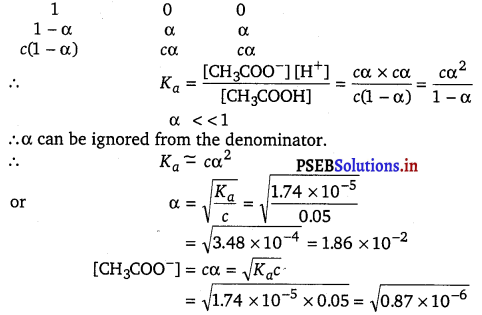
[CH3COO–] = 0.933 x 10-3 = 9.33 x 10-4 M
pH = – log[H+] = – log (9.33 x 10-4)
= – (-4) – log9.3 = 4 – 0.9 = 3.03
Question 47.
It has been found that the pH of a 0.01M solution of an organic acid is 4.15. Calculate the concentration of the anion, the ionization constant of the acid and its pKa.
Answer:
Let the organic acid be HA.
⇒ HA ⇌ H+ + A–
Concentration of HA = 0.01 M
pH = 4.15
-log[H+] = pH= 4.15
log[H+] = – 4.15
log[H+] = 5.85
[H+] = antilog \(\overline{5} .85\)
= 7.080 x 10-5
Ka = \(\frac{\left[\mathrm{H}^{+}\right]\left[\mathrm{A}^{-}\right]}{[\mathrm{HA}]}\)
Now, [H+] = [A–] = 7.08 x 10-5 M
Then Ka = \(
Ka = 5.01 x 10-7
PKa = – logKa = – log(5.01 x 10-7)
pKa = 7 – 0.699 = 6.301
Question 48.
Assuming complete dissociation, calculate the pH of the following solutions:
(a) 0.003 M HCl
(b) 0.005 M NaOH
(c) 0.002 M HBr
(d) 0.002 M KOH
Answer:
(a) HCl (aq) ⇌ H+ (aq) + Cl–(aq)
[HCl]= 0.003 M
As HC1 is completely dissociated into H+ ions
∴ [H+] = [HCl] = 0.003 M
pH = – log[H+] = – log [3 x 10-3]
= 3 + (-0.4771) = 2.523
(b) NaOH(aq) ⇌ Na+(aq) + OH– (aq)
[NaOH] = 0.005 = 5 x 10-3 M
[OH–] = [NaOH] = 5 x 10-3 M
∴ [latex]\left[\mathrm{H}^{+}\right]=\frac{K_{w}}{\left[\mathrm{OH}^{-}\right]}=\frac{1.0 \times 10^{-14}}{5.0 \times 10^{-3}}\)
[H+]= 2.0 x 10-12
∴ pH = – log(2 x 10-12) = – (-12) – log2
= 12 – 0.30 = 11.70
[log2 = 0.30]
(c)
![]()
[HBr] = 0.002 M
[H+]= [HBr] = 0.002 M= 2.0 x 10-3 M
pH = – log[H+] = – log[2 x 10-3]
=- (-3) – log2
= 3 – log2
= 3 – 0.3 = 2.70
![]()
(d)
![]()
[OH–] = 0.002 M
[H+] = \(\frac{K_{w}}{\left[\mathrm{OH}^{-}\right]}=\frac{1.0 \times 10^{-14}}{0.002}\) = 2 x 10-12
pH = – log[H+] = -(-12) – log 5 = 12 – 0.70 = 11.30
Question 49.
Calculate the pH of the following solutions:
(a) 2 g of TIOH dissolved in water to give 2 litre of solution.
(b) 0.3 g of Ca(OH)2 dissolved in water to give 500 niL of solution.
(c) 0.3 g of NaOH dissolved in water to give 200 mL of solution.
(d) 1 mL of 13.6 M HC1 is diluted with water to give 1 litre of solution.
Answer:
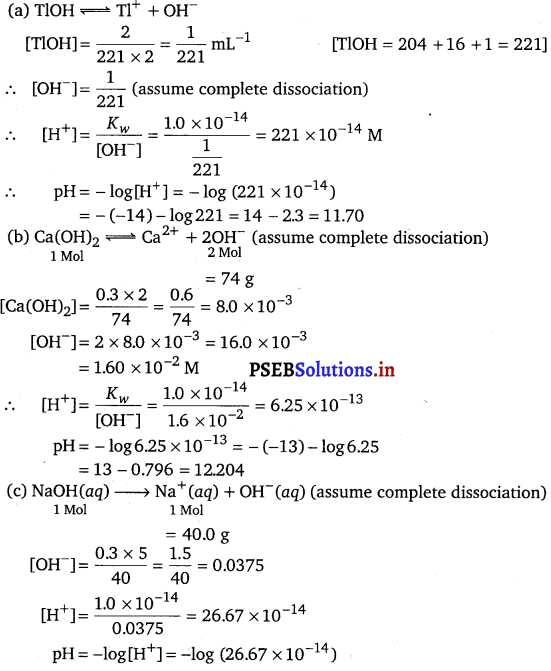
(d) 1 mL of 13.6 M HC1 is diluted with water to give 1 litre of solution HC1 is completely dissociated to give H+ ions
[HCl] = ?
M1V1 = M2V2
1 mL of 13.6 M HCl = 1000 mL of M2
M2 = \(\frac{1 \times 13.6}{1000}\) = 0.0136 M
[HC1] = [H+] = 0.0136 M pH = – log[H+] = – log(1.36 x 10-2)
= – (-2) – log 1.36 = 2 – 0.13 = 1.87
Question 50.
The degree of ionization of a 0.1 M bromoacetic acid solution is 0.132. Calculate the pH of the solution and the pKa of bromoacetic acid.
Answer:
α (Degree of ionization) = 0.132
c (molar cone.) = 0.1 M

∴ H+ = c x α = 0.1 x 0.132 = 0.0132
pH = – logH+ = – log(1.32 x 10-2)
= – (-2) – log 1.32 = 2 – 0.12 = 1.88
pKa = -logKa
Now, Ka = cα2
Ka = 0.1 x (0.132)2 = 1.74 x 10-3
∴ pKa = – log (1.74 x 10-3) = – (-3) – log1.74 = 3 – 0.24 = 2.76
Question 51.
The pH of 0.005 M codeine (C18H21NO3) solution is 9.95.
Calculate its ionization constant and pKb.
Answer:
Molar cone, of codeine, c = 0.005 = 5 x 10-3
pH = 9.95
pOH = 14 – 9.95 = 4.05 (∵ pH + pOH = 14)
pOH = – log [OH–]
log[OH–] = -4.05= \(\overline{5} .95\)
[OH–] = antilog \(\overline{5} .95\)
= 8.91 x 10-5
kb = \(\left(\frac{8.91 \times 10^{-5}}{5 \times 10^{-3}}\right)^{2}\) = 1.588 x 10-6
pKb = – logKb = – log(1.588 x 10-6)
= 6 + (-0.2009) = 5.7991 = 5.80
![]()
Question 52.
What is the pH of 0.001 M aniline solution? The ionization constant of aniline can be taken from table 7.7 (427 x 10-10). Calculate the degree of ionization of aniline in the solution. Also calculate the ionization constant of the conjugate acid of aniline.
Answer:
Given, Kb = 4.27 x 10-10, c = 0.001 M
\(\mathrm{C}_{6} \mathrm{H}_{5} \mathrm{NH}_{2}+\mathrm{H}_{2} \mathrm{O} \rightleftharpoons \mathrm{C}_{6} \mathrm{H}_{5} \mathrm{NH}_{3}^{+}+\mathrm{OH}^{-}\)

[0H] = 6.534 x 10-7
pOH = — log(6.534 x 10-7)
= 7+ (-0.8152)= 6.18
pH + pOH =14
pH 14—6.18=7.82
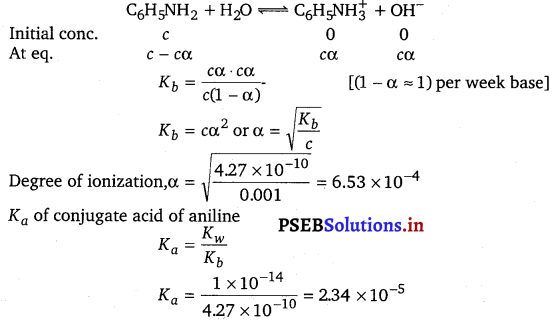
Thus, the ionization constant of the conjugate acid of aniline is 2.34 x 10-5.
Question 53.
Calculate the degree of ionization of 0.05 M acetic acid if its pKa value is 4.74.
How is the degree of dissociation affected when its solution also contains (a) 0.01 M (b) 0.1 M in HCl?
Answer:
PKa = – log Ka,
4.74 =-logKa
log Ka = -4.74 = \(\overline{5} .26\)
Ka = antilog \(\overline{5} .26\) = 1.82 x 10-5
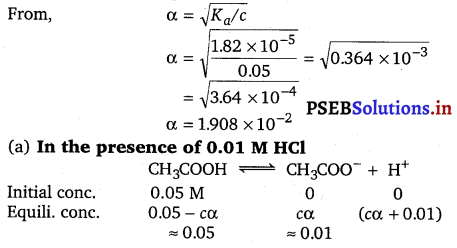
[CH3COOH is a weak acid and HC1 is a strong acid, so we can assume
that (cα + 0.01) 0.01]
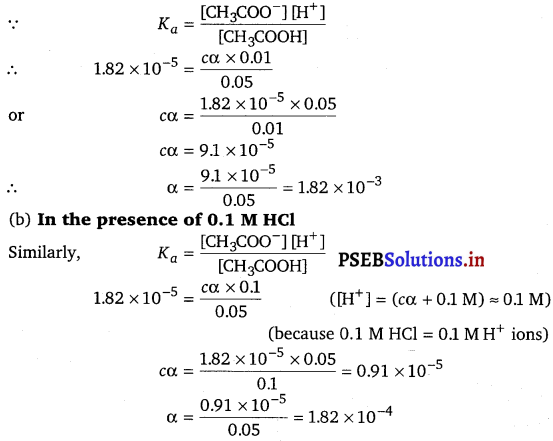
In the presence of strong acid, dissociation of weak acid i.e., CH3COOH decreases due to common ion effect.
Q.54. The Ionization constant of dimethylanilne is 54 x 10.
Calculate Its degree of ionization in its 0.02 M solution. What
percentage of dimethylamine is ionized if the solution is also
0.1MInNaOH?
Ans. Given, Kb = 5.4 x 10
c=0.02M
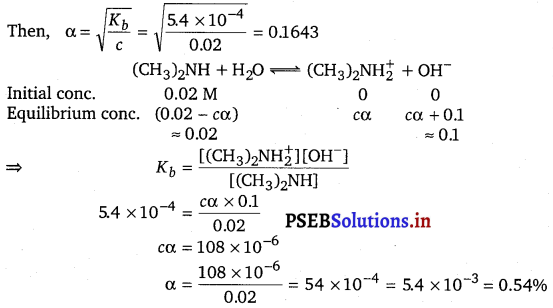
It means that in the presence of 0.1 M NaOH, 0.54% of dimethylamine will get dissociated.
Question 55.
Calculate the hydrogen ion concentration in the following biological fluids whose pH are given below :
(a) Human muscle-fluid, 6.83 (b) Human stomach fluid, 1.2
(c) Human blood, 7.38 (d) Human saliva, 6.4.
Answer:
(a) pH of Human muscle fluid = 6.83
pH = – log[H+] log[H+] = -6.83 = \(\overline{7} .17\)
[H+] = antilog \(\overline{7} .17\)
[H+] = 1.48 x 10-7 M
(b) pH of Human stomach fluid =1.2
log[H+] = -1.2 = \(\overline{2} .80\)
[H+] = antilog \(\overline{2} .80\)
.-. [H+] = 6.3 x 10-2 M
(c) pH of Human blood = 7.38
log[H+] = – 7.38 = \(\overline{8} .62\)
.-. [H+] = antilog \(\overline{8} .62\) = 4.17 x 10-8 M
(d) pH of Human saliva = 6.4
log[H+] =-6.4 = \(\overline{7} .60\)
[H+] = antilog \(\overline{7} .60\) = 3.98 x 10-7 M
Question 56.
The pH of milk, black coffee, tomato juice, lemon juice and egg white are 6.8, 5.0, 4.2, 2.2 and 7.8 respectively. Calculate corresponding hydrogen ion concentration in each.
Answer:
The hydrogen ion concentration in the given substances can be calculated by using the given relation: pH = – log[H+]
(i) pH of milk = 6.8
Since, pH = -log[H+]
6.8 = -log[H+] log[H+] = -6.8 = \(\overline{7} .20\)
[H+] = antilog (\(\overline{7} .20\)) = 1.5 x 10~7 M
(ii) pH of black coffee = 5.0
Since, pH = – log[H+]
5.0 = – log[H+] log[H+] = – 5.0
[H+] = antilog (-5.00) = 10-5 M
(iii) pH of tomato juice = 4.2
Since, pH = – log[H+]
4.2 = – log[H+]
log[H+] = – 4.2 = \(\overline{5} .80\)
[H+] = antilog (\(\overline{5} .80\)) = 6.31 x 10-5M
(iv) pH of lemon juice = 2.2
Since, pH = – log[H+]
2.2 = – log[H+]
log[H+] = -2.2 = \(\overline{3} .8\)
[H+] – antilog (\(\overline{3} .8\)) = 6.31 x 10-3 M
![]()
(v) pH of egg white = 7.8
Since, pH = -log[H+]
7.8 = – log[H+]
log[H+]= -7.8 = \(\overline{8} .20\)
[H+] = antilog (\(\overline{8} .20\)) = 1.58 x 10-8 M
Question 57.
0.561 g of KOH is dissolved in water to give 200 mL of solution at 298 K. Calculate the concentrations of potassium, hydrogen and hydroxyl ions. What is its pH?
Answer:
Molar cone, of KOH = \(\frac{0.561 \times 1000}{56.1 \times 200}\) = 0.05M
56.1 x 200
KOH being a strong electrolyte, is completely ionized in aqueous solution.
KOH(aq) ⇌ K+(aq) + OH–(aq)
[OH–] = 0.05 M = [K+]
[H+][OH–] = kw
[H+] = \(\) = 2 x 10-13
pH = – log[H+] = – log[2 x 10-13]
= – (-13) – log2 = 13 – 0.03
∴ pH = 12.70
Question 58.
The solubility of Sr(OH)2 at 298 K is 19.23 g/L of solution. Calculate the concentrations of strontium and hydroxyl ions and the pH of the solution.
Answer:
Solubility of Sr(OH)2 = 19.23 g/L
Then, concentration of Sr(OH)2 = \(\frac{19.23}{121.63 \times 1}\) M = 0.1581 M
Sr(OH)2(aq) Sr2+(aq) + 2(OH–)(aq)
∴ [Sr2+] = 0.1581 M
[OH–] – 2 x 0.1581 M = 0.3162 M
Now
Kw = [OH–] [H+]
\(\frac{1 \times 10^{-14}}{0.3162}\) = [H+]
[H+] = 3.16 x 10-14
pH = – log[H+]
pH = 14 – 0.4997 = 13.5003 ≈ 13.5
Question 60.
The pH of 0.1 M solution of cyanic acid (HCNO) is 2.34. Calculate the ionization constant of the acid and its degree of ionization in the solution.
Answer:
Given, pH = 2.34
Molar cone, (c) = 0.1 M
HCNO H+ + CNO–
pH = – log[H+]
2.34 = -log[H+]
log[H+] =-2.34 = \(\overline{3} .66\)
.-. [H+] = antilog \(\overline{3} .66\) = 4.57 x 10-3 M
[H+] = \(\sqrt{K_{a}^{c}}\)
4.57 x 10-3 = \(\sqrt{K_{a}^{c}}\)
Ionization constant,
Ka = 2.088 x 10-4
Degree of ionization α = \(\sqrt{\frac{K_{a}}{c}}=\sqrt{\frac{2.088 \times 10^{-14}}{0.1}}\)
α = 0.0457
Question 61.
The ionization constant of nitrous acid is 45 x 104. Calculate the pH of 0.04 M sodium nitrite solution and also its degree of hydrolysis.
Answer:
Hydrolysis constant Kh = \(\frac{K_{w}}{K_{a}}\)
where Kw = Ionic product of water, Ka = Ionisation constant of the acid
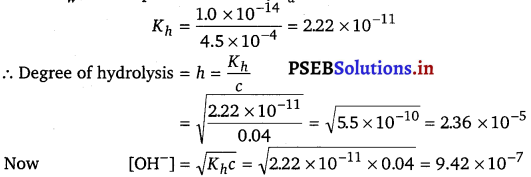
pOH = -log(9.42 x 10-7)= 7-0.97= 6.03
∴ pH = 14 – pOH = 14 – 6.03 = 7.97
Question 62.
A 0.02 M solution of pyridinium hydrochloride has pH = 3.44. Calculate the ionization constant of pyridine.
Answer:
Given, pH = 3.44
We know that,
PH = – log[H+]
.-. [H+]= 3.63 x 10-4
Then Kh = \(\frac{\left(3.63 \times 10^{-4}\right)^{2}}{0.02}\) (Concentration = 0.02M)
=> Kh = 6.6 x 10-6
Now, Kh = \(\frac{K_{w}}{K_{a}}\)
Ka = \(\frac{K_{w}}{K_{h}}=\frac{1 \times 10^{-14}}{6.6 \times 10^{6}}\)
= 1.51 x 10-9
![]()
Question 63.
Predict if the solutions of the following salts are neutral, acidic or basic:
NaCl, KBr, NaCN, NH4NO3, NaNO2 and KF
Answer:
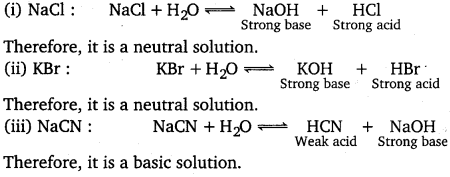
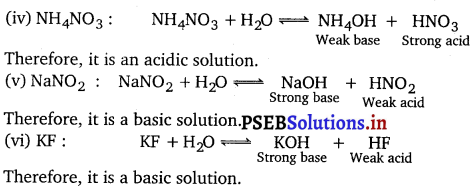
Question 64.
The ionization constant of chloroacetic acid is 1.35 x 10-3 . What will be the pH of 0.1 M acid and its 0.1 M sodium salt solution?
Answer:
Given that Ka = 1.35 x 10-3.
=> Ka = cα2
α = \(\sqrt{\frac{K_{a}}{c}}=\sqrt{\frac{1.35 \times 10^{-3}}{0.1}}\)
(∵ Concentration of acid = 0.1 M)
= \(\sqrt{1.35 \times 10^{-2}}\) =0.116
.-. [H+]= cα = 0.1 x 0.116 = 0.0116
=> pH = – log[H+] = – log[0.0116] = 1.94
To find pH of 0.1 M sodium salt, we use the formula
pH = – \(\frac{1}{2}\)[log Cw + log Ka – log c]
= –\(\frac{1}{2}\)[log1 x 10-14 + log(1.35 x 10-3) – log(0.1)]
= –\(\frac{1}{2}\)[-14 + (-3 + 0.1303) – (-1)]
= – \(\frac{1}{2}\) [-15.8697] = 7.93485 ≈ 7.94
Question 65.
Ionic product of water at 310 K is 2.7 x 10-14. What is the pH of neutral water at this temperature?
Answer:
Ionic product,
Kw = [H3O+] [OH–]
= 2.7 x 10-14 at 310 K
H2O + H2O *=* [H30+][OH–]
[H30+]= [OH–]
Therefore, [H30+] = \(\sqrt{2.7 \times 10^{-14}}\)
⇒ = 1.64 x 10-7 M
⇒ [H30+] = 1.64 x 10-7
⇒ pH = – log[H30+] = – log[1.64 x 10-7 = 6.78
Hence, the pH of neutral water is 6.78.
Question 66.
Calculate the pH of the resultant mixtures :
(a) 10 mL of 0.2 M Ca(OH)2 + 25 mL of 0.1 M HC1
(b) 10 mL of 0.01 M H2SO4 + 10 mL of 0.01 M Ca(OH)2
(c) 10 mL of 0.1 M H2SO4 + 10 mL of 0.1 M KOH
Answer:
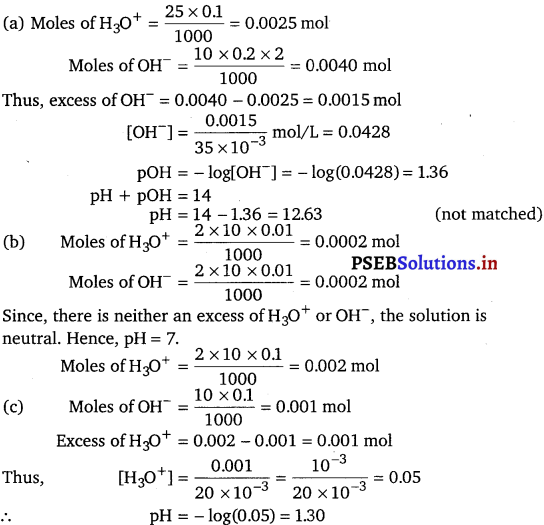
Question 67.
Determine the solubilities of silver chromate, barium chromate, ferric hydroxide, lead chloride and mercurous iodide at 298 K from their solubility product constants.
[Ksp(Ag2CrO4) = 1.1 x 10-12, Ksp(BaCrO4) = 1.2 x 10-10,
Ksp[Fe(OH)3] = 1.0 x 10-38, Ksp(PbCl2) = 1.6 x 10-5
Ksp(Hg2I2) = 4.5 x 10-29]
Determine also the molarities of individual ions.
Answer:
(i) Silver chromate : Ag2CrO4⇌ 2Ag+ + CrO42-, Ksp = 1.1 x 10-12
Then, Ksp = [Ag+]2[CrO42-]
Let the solubility of Ag2CrO4 be s.
⇒ [Ag+] = 2s and [CrO42-] = s
Then, Ksp = (2s)2 s – 4s3
⇒ 1.1 x 10-12 = 4s3
0.275 x 10-12 = s3
s = 0.65 x 10-4 M
Molarity of Ag+ = 2s = 2 x 0.65 x 10-4
= 1.30 x 10-4 M
Molarity of CrO42- = s = 0.65 x 10-4 M
(ii) Barium chromate : BaCrO4 ⇌ Ba2+ + \(\mathrm{CrO}_{4}^{2-}\); Ksp = 1.2 x 10-10
Then, Ksp = [Ba2+] [latex]\mathrm{CrO}_{4}^{2-}[/latex]
Let s be the solubility of BaCrO4.
⇒ [Ba2+] = s and [latex]\mathrm{CrO}_{4}^{2-}[/latex] = s
⇒ Ksp = s2
⇒ 1.2 x 10-10 = s2
⇒ s = 1.09 x 10-5 M
Molarity of [Ba2+] = Molarity of [latex]\mathrm{CrO}_{4}^{2-}[/latex] = s = 1.09 x 10-5 M
(iii) Ferric hydroxide: Fe(OH)3 ⇌ Fe2+ + 3OH–; Ksp = 1.0.x 10-38
Ksp = [Fe2+][OH–]3
Let s be the solubility of Fe(OH)3
⇒ [Fe3+] = s and [OH–] = 3s
⇒ Ksp = s. (3s)3 = s x 27x3
Ksp = 27x4
1.0 x 10-38 = 27x4
0.037 x 10-38 = s4
0.00037 x 10-36 = s4
s = 1.39 x 10-10 M
Molarity of [Fe3+] = s = 1.39 x 10-10 M
Molarity of [OH–] = 3s = 4.17 x 10-10 M
(iv) Lead chloride : PbCl2 ⇌ Pb2+ + 2Cl–; Ksp = 1.6 x 10-5
Ksp = [Pb2+][Cl–]2
Let s be the solubility of PbCl2.
⇒ [Pb2+] = s and [Cl–] = 2s
Thus, Ksp = s. (2s)2 = 4s3
⇒ 1.6 x 10-5 = 4s3
⇒ 0.4 x 10-5 = s3
4 x 10-6 = s3
⇒ s = 1.59 x 10-2 M
Molarity of [Pb2+] = s = 1.59 x 10-2 M
Molarity of [Cl–] = 2s = 3.18 x 10-2 M
![]()
(v) Mercurous iodide : Hg2I2 ⇌ \(\mathrm{Hg}_{2}^{2+}\) + = 4.5 x 10-29
Ksp = [\(\mathrm{Hg}_{2}^{2+}\) ] []I–]
Let s be the solubility of [Hg2I2]
⇒ [Hg2] = s and [I–] = 2s
Ksp = (s).(2s)2 = 4s3
⇒ 4s3 = 4.5 x 10-29
⇒ s3 = 1.125 x 10-29
s = 2.24 x 10-10 M
Molarity of [ \(\mathrm{Hg}_{2}^{2+}\) ] = s = 2.24 x 10-10 M
Molarity of [I–] = 2s = 4.48 x 10-10 M.
Question 68.
The solubility product constant of Ag2CrO4 and AgBr are
1.1 x 10-12 and 5.0 x 10-13 respectively. Calculate the ratio of the molarities of their saturated solutions.
Answer:
Let s be the solubility of Ag2CrO4
Thus, Ag2CrO4 ⇌ 2Ag2+ + \(\mathrm{CrO}_{4}^{-}\); Ksp = 1.1 x 10-12
Ksp = [Ag2+]2. [latex]\mathrm{CrO}_{4}^{-}[/latex]
=> [Ag2+] = (2s)2 and [latex]\mathrm{CrO}_{4}^{-}[/latex] = s
Ksp = (2s)2. s= 4s3
1.1 x 10-12 = 4s3
s = 6.5 x 10-5 M
Let s be the solubility of AgBr.
AgBr(s) ⇌ Ag+ + Br–; Ksp = 5.0 x 10-13
Ksp = s2 = 5.0 x 10-13
s = \(\sqrt{5.0 \times 10^{-13}}\)
∴ s = 7.07 x 10-7 M
Therefore, the ratio of the molarities of their saturated solution is
\(\frac{s\left(\mathrm{Ag}_{2} \mathrm{CrO}_{4}\right)}{s(\mathrm{AgBr})}=\frac{6.5 \times 10^{-5} \mathrm{M}}{7.07 \times 10^{-7} \mathrm{M}}\) = 9.19
Question 69.
Equal volumes of 0.002 M solutions of sodium iodate and cupric chlorate are mixed together. Will it lead to precipitation of copper iodate? (For cupric iodate, Ksp = 7.4 x 10-8).
Ans. 2NaIO3 + Cu(ClO3)3 → 2NaClO3 + Cu(IO3)2
Molar cone, of both solutions before mixing = 0.002 M
Molar cone, of both solution after mixing
\(\left[\mathrm{IO}_{3}^{-}\right]=\left[\mathrm{Cu}^{2+}\right]=\frac{0.002}{2}\)= 0.001 M
Cu(IO3)2 ⇌ Cu2+ + \(2 \mathrm{IO}_{3}^{-}\)
[Cu2+] = 0.001 M
\(\) = 0.001 M
Ionic product = [Cu2+]\(\left[\mathrm{IO}_{3}^{-}\right]^{2}\)
– 1 x 10-3 x [1 x 10-3]2 = 1 x 10-9
Ksp = 7.4 x 10-8
Cu(IO3)2 is precipitated if [Cu2+] .\(\left[\mathrm{IO}_{3}^{-}\right]^{2}\) > Ksp
Since, the ionic product is less than the solubility product. Hence there will be no precipitation.
Question 70.
The ionization constant of benzoic acid is 6.46 x 10-5 and Ksp for silver benzoate is 2.5 x 10 . How many times is silver benzoate
more soluble in a buffer of pH 3.19 compared to its solubility in pure water?
Answer:
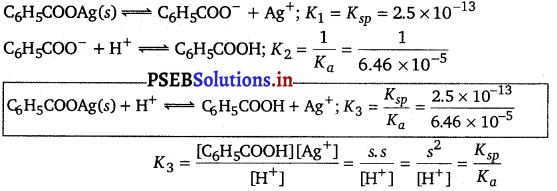
where s is the solubility of C6H5COOAg
pH = 3.19
pH = -log[H+]
log[H+] = – pH = -3.19 = \(\overline{4} .81\)
[H+] = antilog \(\overline{4} .81\) = 6.46 x 10-4
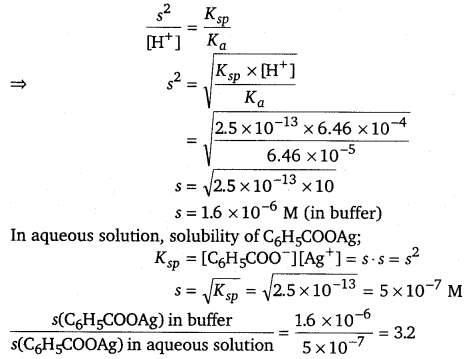
C6H5COOAg is 3.2 times more soluble in buffer than in pure water.
